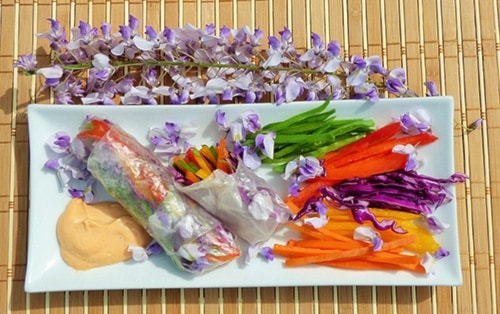It’s no secret that I’m a ‘plantaholic’, but those that offer something to eat (be it flowers, fruit or foliage) hold a special place in my heart.
I think it all goes back to my childhood – no matter where I lived in Western Canada, I always managed to find something to munch on – be it alpine strawberries and Saskatoon Berries in Saskatchewan, wild plums and chokecherries in Winnipeg or crabapples (found on abandoned farms) and blackberries in British Columbia.
My life’s motto at that time was, “Give a kid a pocketfull of crabapples and the world is his oyster.”
It seems that I’m reliving my childhood by entering a whole new phase of edible exploration with my most-recent foray being fresh spring rolls with edible wisteria blossoms.
While other parts of this common vine are toxic to some degree, the fresh flowers (in moderation) have a sweet, nutty flavour that lends its subtle charms to fresh salads or vegetarian spring rolls.
I chose to put together the latter and julienned snow peas, young carrots, purple cabbage and red and yellow sweet peppers – adding about four to five wisteria blossoms to each roll.
While I’ll admit that it took several attempts to reconstitute the rice paper and roll it without it sticking to everything, eventually I got the hang of it.
You can lightly dress the ingredients before rolling but I chose to concoct my own olive oil-based mayonnaise blended with Sriracha sauce for a spicy dip. I can assure you, that it tasted as good as it looked.
Getting back to the ornamental values of this vigorous vine, there are few plants which rival the showy, spring display of pendulous racemes in hues of white, pink, lilac or purple.
For the most part, we are dealing with three common species – Japanese (Wisteria floribunda), Chinese (Wisteria sinensis), Kentucky (Wisteria frutescens var. macrostachya) and the hybrid Wisteria x formosa (a Japanese-Chinese cross) known as Issai or Domino.
They all have their little quirks, such as the Japanese wisteria twining clockwise and W. sinensis twining in the opposite direction. These robust vines also require a sturdy structure for support as the branches gain girth with age and will break any lumber less than 2 x 2” in diameter – so those flimsy lathe panels just won’t do.
It’s also not a good idea to plant them too close to trees where they can quickly scramble into the crown or near foundation drains, which their aggressive roots will often plug.
Many have fragrant blooms (except for the Kentucky wisteria) but the longer flower clusters are mostly found in the Japanese cultivars (up to 75 cm long). Being nice to your vine by regular fertilizing and watering will only get you a lot of growth in the form of foliage, but few flowers, so keep things lean for the best display of blooms.
Pruning established vines is done twice a year; in summer, prune new shoots in July-August back to six leaves and head these same shoots back to two to three buds in January or February, as well as doing any structural pruning.
While we are running a bit late to find a full selection of wisteria at your local garden centre, a few choice cultivars to look for include f. Alba (pure white), s. Amethyst (violet-blue), f. Black Dragon (also known as Violacea Plena / double dark violet-purple), Domino (also known as Issai, violet and white), Caroline (bluish-purple), s. Prolific (lilac-blue) and f. Rosea (rose-pink) – all of which taste as good as they look.
Mike Lascelle is a local nursery manager and gardening author: hebe_acer@hotmail.com
